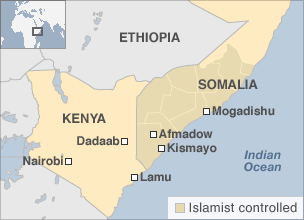Tweets update on Kenya-led anti-Al-Shabaab operations
 Social media fueled the “Arab Spring” uprisings that toppled long-standing regimes in North Africa, and spearheaded relief efforts in the aftermath of the Turkish earthquake.
Social media fueled the “Arab Spring” uprisings that toppled long-standing regimes in North Africa, and spearheaded relief efforts in the aftermath of the Turkish earthquake.
Today, anyone with a Tweeter account can receive updates on Kenyan military operations in Somalia aimed at reducing the threat posed by the Al-Qaeda-affiliated militant group: Al-Shabaab.
According to the Washington Post, Kenya sent troops into Somalia earlier in October in response to a series of cross-border kidnappings and grenade blasts in its capital Nairobi alleged to have been carried out by the Somali Islamist group, which controls most of southern Somalia.
Major Emmanuel Chirchir, Kenya’s military spokesman, offers updates, via Twitter, on military operations targeting Al-Shabaab. Tweeter users can also ask questions, send their message of support to Kenyan troops, and offer feedback on events on the ground, via the #operationlindanchi hashtag.
“The strategy remains to reduce Al-Shabaab effectiveness and restore the Transitional Federal Government (TFG) authority,” Maj Chirchir said on his official Twitter account.
On Wednesday, the Kenyan Defense Forces (KDF) “engaged Al-Shabaab in their camp in the Busar area, exchanged fire and 12 Al Shabaab players [were] killed”, he added.

Earlier in the month, the KDF sank a boat killing 18 Al-Shabaab fighters and footage of the operation is available on YouTube.
“The boat was challenged to stop for identification but continued to approach the Kenya Navy at high speed -fired at”, Maj. Chirchir tweeted.
Maj. Chirchir has also used Twitter to ask people with relatives and friends of civilians located in Al-Shabaab-controlled towns to vacate premises due to imminent KDF attacks on the militant group. Since Al-Shabaab has resorted to using donkeys to transport their weapons, Maj. Chirchir warned that any large concentration and movement of loaded donkeys will be considered as Al-Shabaab activity.
Decades of civil conflict allows war lords, pirate gangs, and militant groups to control parts of the country and challenge the authority of the internationally-backed Transitional Federal Government (TFG). Kenyan troops add to Ugandan and Burundian contingencies already present. With the abduction of aid workers, killings of civilians in Uganda and Kenya, Al-Shabaab is fast becoming a regional security issue.




































